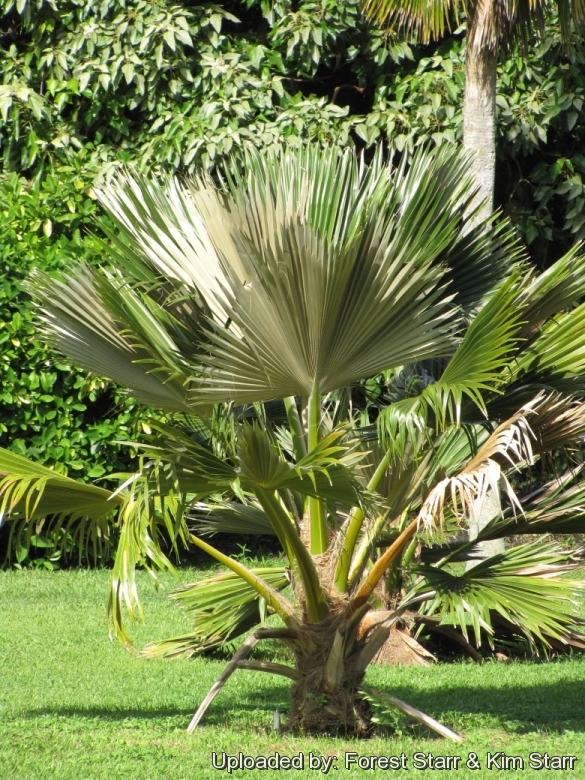
Pritchardia arecina Photo by: Forest Starr & Kim Starr
Habit at Kahanu Gardens NTBG Kaeleku Hana, Maui, Hawaii (USA). November 04, 2009.
Origin and Habitat: Endemic to Maui, Hawaii islands, USA
Altitude: In from about 600 to over 1300 m. A.S.L.
Habitat: Grows in wet forests on the north slope of Haleakalā, East Maui. It tends to alter its appearance in lower elevations and dryer climates.
Synonyms:
Common Names include:
ENGLISH: Maui pritchardia
HAWAIIAN (ʻŌlelo Hawaiʻi): Maui loulu, Noulu, Loulu, Hāwane, Wāhane
Description: Pritchardia arecinaSN|28615]]SN|24622]] is a medium sized species 9-15 m tall, up to 25 cm in diameter. Pritchardia arecinaSN|24622]]SN|24622]] is related to Pritchardia martiiSN|24622]]SN|28615]].
Trunk: Columnar, naked, smooth or fibrous when young, longitudinally grooved, and obscurely ringed by leaf scars.
Crown: 3 or more meters wide
Leaves: Flat, large, strictly palmate (not costapalmate) 90 cm long, somewhat divided, that tend to be pendant as palm ages. with abundant hair-like orange fibres at the base of the leaf stalk on 120 cm petioles, light to medium green above with the undersides with pale yellow to silvery grey hairs.
Flower: The flowers are showy yellow en masse borne in a terminal cluster with simple or compound branches of an arcuate or pendulous inflorescence among the leaves.
Fruit: Large brown to black round to ovoid (Egg-shaped) fruits, 5.5 cm. long, 4 cm. in diameter, will develop on thick, horizontal, hairy fruiting stalks nearly as long as the leaves.
Bibliography: Major references and further lectures
1) Forest & Kim Starr Pritchardia arecina (Loulu). Plants of Hawaii. <http://www.starrenvironmental.com>. Downloaded on 21 August 2014.
2) Palmpedia contributors. "Pritchardia arecina ." Palmpedia, PALM ENCYCLOPEDIA, <http://www.palmpedia.net> Downloaded on 26 Aug. 2014
3) Donald R. Hodel "Loulu-The Hawaiian Pritchardia" in the: The Palm Journal 193, page 12.
4) Native Plants Hawaii. “Pritchardia arecina” web 21 August 2014. >http://nativeplants.hawaii.edu/plant/view/Pritchardia_arecina>
5) David Leaser "Growing Palm Trees in Hawaiʻi and Other Tropical Climates"
6) Don Ellison, Anthony Ellison “Cultivated Palms Of The World” UNSW Press, 01/May/2001
7) Robert Lee Riffle, Paul Craft “An Encyclopedia of Cultivated Palms” Timber Press, Portland 2007
8) "Pritchardia arecina ." PACSOA Palms and Cycads wiki , <http://www.pacsoa.org.au> Accessed on 28 Aug. 2014
9) Pritchardia arecina. (2013, 13 de julio). Wikipedia, La enciclopedia libre. Fecha de consulta: 21:18, septiembre 3, 2014 desde http://es.wikipedia.org/w/index.php?title=Pritchardia_arecina&oldid=68336499.
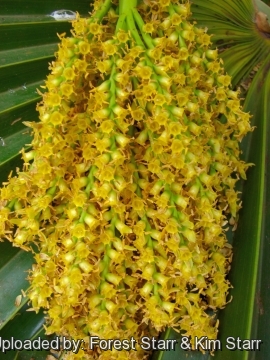 Flowers at Hanamu Rd Makawao, Maui, Hawaii (USA). April 05, 2009. Photo by: Forest Starr & Kim Starr
Flowers at Hanamu Rd Makawao, Maui, Hawaii (USA). April 05, 2009. Photo by: Forest Starr & Kim Starr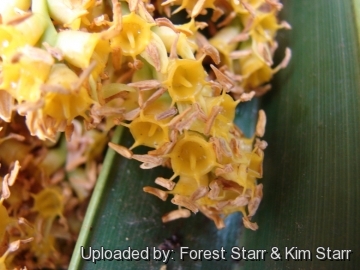 Flowers at Hanamu Rd Makawao, Maui, Hawaii (USA). April 05, 2009. Photo by: Forest Starr & Kim Starr
Flowers at Hanamu Rd Makawao, Maui, Hawaii (USA). April 05, 2009. Photo by: Forest Starr & Kim Starr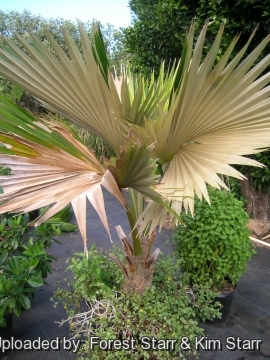 In pot at Hoolawa Farms, Maui, Hawaii (USA). November 08, 2006. Photo by: Forest Starr & Kim Starr
In pot at Hoolawa Farms, Maui, Hawaii (USA). November 08, 2006. Photo by: Forest Starr & Kim Starr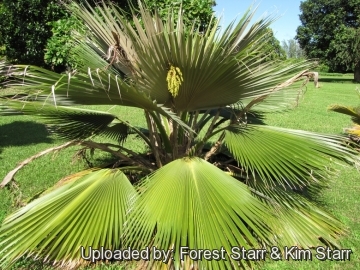 Habit at Kahanu Gardens NTBG Kaeleku Hana, Maui, Hawaii (USA). November 04, 2009. Photo by: Forest Starr & Kim Starr
Habit at Kahanu Gardens NTBG Kaeleku Hana, Maui, Hawaii (USA). November 04, 2009. Photo by: Forest Starr & Kim Starr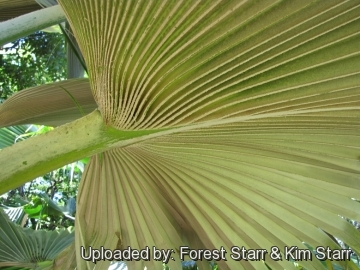 Furry leaf underside at Kahanu Gardens NTBG Kaeleku Hana, Maui, Hawaii (USA). November 04, 2009. Photo by: Forest Starr & Kim Starr
Furry leaf underside at Kahanu Gardens NTBG Kaeleku Hana, Maui, Hawaii (USA). November 04, 2009. Photo by: Forest Starr & Kim Starr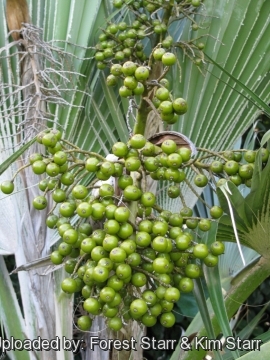 Fruit at Kahanu Gardens NTBG Kaeleku Hana, Maui, Hawaii (USA). November 04, 2009. Photo by: Forest Starr & Kim Starr
Fruit at Kahanu Gardens NTBG Kaeleku Hana, Maui, Hawaii (USA). November 04, 2009. Photo by: Forest Starr & Kim Starr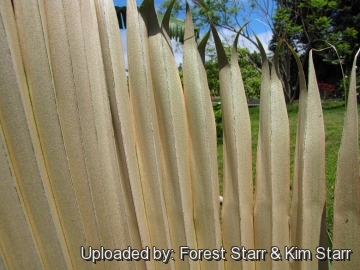 Bronze fur on back of frond at Pololei Haiku, Maui, Hawaii (USA). April 11, 2013. Photo by: Forest Starr & Kim Starr
Bronze fur on back of frond at Pololei Haiku, Maui, Hawaii (USA). April 11, 2013. Photo by: Forest Starr & Kim Starr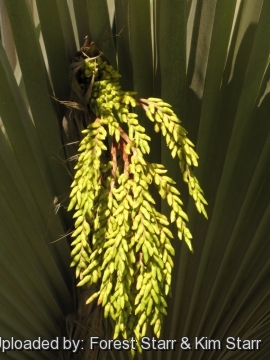 Flowers at Kahanu Gardens NTBG Kaeleku Hana, Maui, Hawaii (USA). November 04, 2009. Photo by: Forest Starr & Kim Starr
Flowers at Kahanu Gardens NTBG Kaeleku Hana, Maui, Hawaii (USA). November 04, 2009. Photo by: Forest Starr & Kim StarrCultivation and Propagation: Pritchardia arecinaSN|24622]]SN|24622]] is an easy to grow palm that likes organic soil, but is adaptable to clay and loam both slightly alkaline and acidic. Good drainage is also important. Pritchardia arecinaSN|24622]]SN|24622]] vary in shape. Specimens raised in dry and/or infertile soils tend to be smaller in stature with smaller leaves. Light also affects the plant's form while those grown in full sun are more compact.
Fertilization: Need a perfect fertilizer diet including all micro nutrients and trace elements or slow release fertilizer. Micronutrient deficiencies are occasional problems. If it doesn't get enough Mn and Fe, the leaves take on a rather unhealthy yellow colour. Micronutrient deficiencies only show up on soil with a high pH. Fertilize often for faster growth
Water Requirements: Needs regular water, do not let dry out between waterings. however it does not want to sit in continually wet, mucky soil. The roots and lower trunk can rot if soil is kept too moist.
Light: Prefers full sun but will tolerate half day sun. .
Hardiness: It is adapted to tropical and subtropical climates but tolerate temperatures down to about -0°C (or even less for short periods) when mature, young plants are more cold sensitive.
Maintenance: Prune diseased, damaged or drying fronds, but do not prune if the frond still has some green colour. Palms recycle nutrients from dead or dying fronds and use them for healthier fronds. Palms only have a set number of new leaves that can sprout and grow per year and removing fronds will not increase that number. If you cut off more than what will grow annually, you could be left with a pretty bare and bald palm.
Early Hawaiian Use The hard wood of the trunk were fashioned into spears. The trunks loulu were notched for climbing to gather the immature fruits and fronds. Older specimens still bear notches that can be seen today. The fronds were used for thatching and as plaiting such as papale (hats) and fans.
Food use: The young fruits called hāwane or wāhane are edible and can be eaten after being peeled. The flavor of fruit with the soft interior is similar to coconut.
Ornamental: It is cultivated as an ornamental tree, and planted in gardens and parks in tropical and sub-tropical climates either as a single specimen or in groups. Culture in containers is possible although growth rates are slower. A bright patio will provide an excellent environment for young specimens which can eventually be planted in a sunny location.
Propagation: Seeds.

















